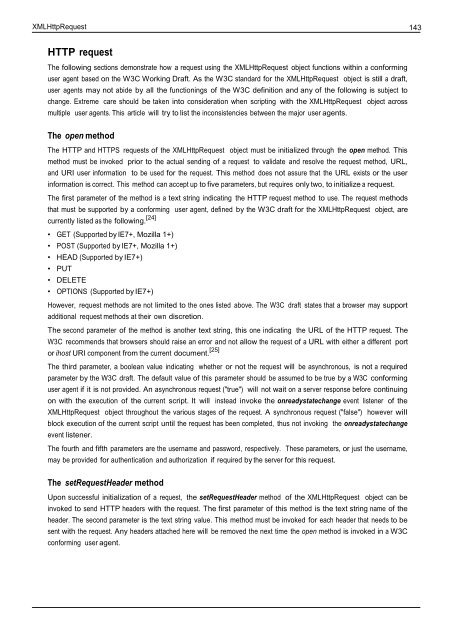Essentials of Javascript - Cultural View
Essentials of Javascript - Cultural View
Essentials of Javascript - Cultural View
Create successful ePaper yourself
Turn your PDF publications into a flip-book with our unique Google optimized e-Paper software.
XMLHttpRequest 143<br />
HTTP request<br />
The following sections demonstrate how a request using the XMLHttpRequest object functions within a conforming<br />
user agent based on the W3C Working Draft. As the W3C standard for the XMLHttpRequest object is still a draft,<br />
user agents may not abide by all the functionings <strong>of</strong> the W3C definition and any <strong>of</strong> the following is subject to<br />
change. Extreme care should be taken into consideration when scripting with the XMLHttpRequest object across<br />
multiple user agents. This article will try to list the inconsistencies between the major user agents.<br />
The open method<br />
The HTTP and HTTPS requests <strong>of</strong> the XMLHttpRequest object must be initialized through the open method. This<br />
method must be invoked prior to the actual sending <strong>of</strong> a request to validate and resolve the request method, URL,<br />
and URI user information to be used for the request. This method does not assure that the URL exists or the user<br />
information is correct. This method can accept up to five parameters, but requires only two, to initialize a request.<br />
The first parameter <strong>of</strong> the method is a text string indicating the HTTP request method to use. The request methods<br />
that must be supported by a conforming user agent, defined by the W3C draft for the XMLHttpRequest object, are<br />
currently listed as the following. [24]<br />
• GET (Supported by IE7+, Mozilla 1+)<br />
• POST (Supported by IE7+, Mozilla 1+)<br />
• HEAD (Supported by IE7+)<br />
• PUT<br />
• DELETE<br />
• OPTIONS (Supported by IE7+)<br />
However, request methods are not limited to the ones listed above. The W3C draft states that a browser may support<br />
additional request methods at their own discretion.<br />
The second parameter <strong>of</strong> the method is another text string, this one indicating the URL <strong>of</strong> the HTTP request. The<br />
W3C recommends that browsers should raise an error and not allow the request <strong>of</strong> a URL with either a different port<br />
or ihost URI component from the current document. [25]<br />
The third parameter, a boolean value indicating whether or not the request will be asynchronous, is not a required<br />
parameter by the W3C draft. The default value <strong>of</strong> this parameter should be assumed to be true by a W3C conforming<br />
user agent if it is not provided. An asynchronous request ("true") will not wait on a server response before continuing<br />
on with the execution <strong>of</strong> the current script. It will instead invoke the onreadystatechange event listener <strong>of</strong> the<br />
XMLHttpRequest object throughout the various stages <strong>of</strong> the request. A synchronous request ("false") however will<br />
block execution <strong>of</strong> the current script until the request has been completed, thus not invoking the onreadystatechange<br />
event listener.<br />
The fourth and fifth parameters are the username and password, respectively. These parameters, or just the username,<br />
may be provided for authentication and authorization if required by the server for this request.<br />
The setRequestHeader method<br />
Upon successful initialization <strong>of</strong> a request, the setRequestHeader method <strong>of</strong> the XMLHttpRequest object can be<br />
invoked to send HTTP headers with the request. The first parameter <strong>of</strong> this method is the text string name <strong>of</strong> the<br />
header. The second parameter is the text string value. This method must be invoked for each header that needs to be<br />
sent with the request. Any headers attached here will be removed the next time the open method is invoked in a W3C<br />
conforming user agent.










